As my life continues to change, I’ve have been doing a huge amount of sorting out of my resources and deciding what brings me joy and that I wish to keep. My collection of magnifiers is one example. Over the years I’ve collected and used many different types with children. All have their value and all have their limitations. But all are magical to me because to look at something close up opens new ways of looking, thinking and being.
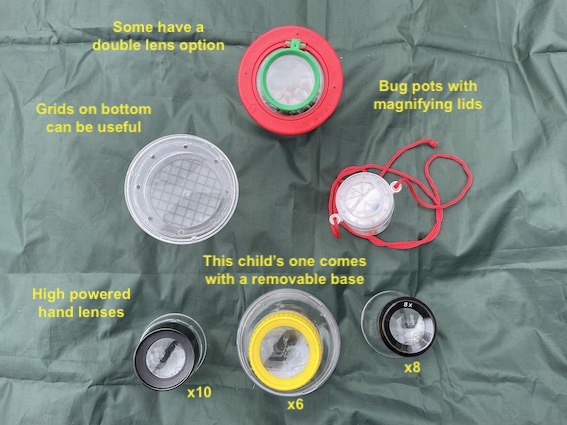
Many magnifiers with different names and purposes
It’s easy to find a range magnifying glasses amongst the science toys in a shop or online and through education suppliers. However, a much more interesting range becomes available if you think about how magnifiers are used in a range of jobs. For example, geologists traditionally have powerful little ones to examine rocks in the field. Jewellers and watchmakers use them for their fine detail. You may find some are called “loupes” but this tends to be for smaller, high-powered lenses.
Keep a magnifying tool in your pocket
Looking through your own magnifier at what children are looking at can help. For this reason, having a magnifier continuously in your pocket can be a very useful item. Interestingly, the children who attend Skogsmulle sessions in Sweden and elsewhere, all have their own magnifiers so they can look closely as and when they wish too. This can also help children learn to use and look after their magnifier as it’s their responsibility and belongs to them.
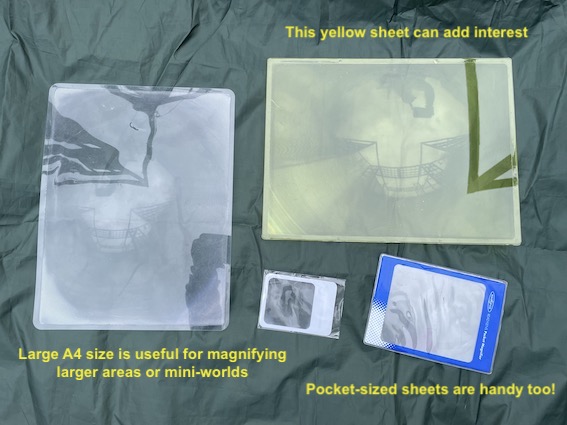
Support your children to notice what they see through a magnifier
Children enjoy different ways of exploring their environment. Using a range of magnifiers can help with this interest and observing the world around them in a novel way that spurs imaginative, creative, linguistic, scientific and mathematical conversations and thinking. A simple prompt such as “What do you see?” or “What are you noticing?” can be great along with talking about what is the same and what is different about an object seen through a lens rather just as it is.
Consider the scales of magnification are most suited to the development age of your children and their ability to use a magnifier
The higher the magnification, the closer to your eye you will need to hold a magnifier. It is also likely to be a smaller lens. Very powerful lenses may come with a build in light as good lighting becomes important. They take more skill and practice to use if they are handheld. If you work with very young children who express a sustained interest in magnification, then it’s probably better to go for a child-friendly digital microscope where the close up can be viewed on a tablet or computer.
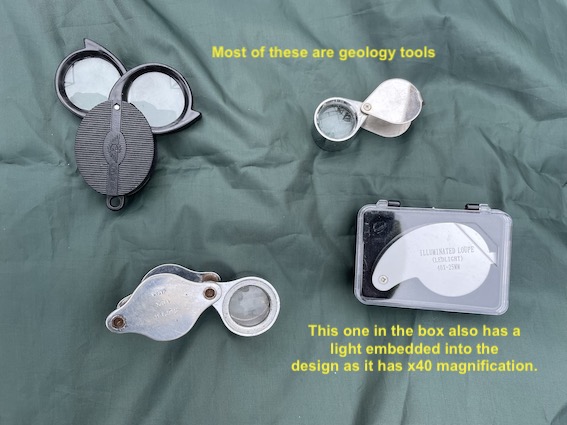
Have a variety of different types of magnifying tools
One type of magnifier will not suit all your children’s eyes, their range of near vision abilities, their hand-eye coordination or the range of objects and items they may wish to explore. As a generally rule, large magnifying sheets are helpful for very young children or ones which enable a magnifier to be held with two hands. Stand magnifiers may be also be of value as this enables a hands free option. It also helps children learn to transfer their knowledge of using a magnifier to a range of different ones and learn which is best suited for specific purposes.
Children’s specific needs
If you work with children who have Additional Support Needs then websites such as Living Made Easy can be really helpful. They have many suggestions about different magnifiers for different purposes. For children with visual impairments, then RNIB website is a good first port of call, not least to seek advice.

Ensure your children learn how to look after your collection of magnifying tools
Magnifiers are tools. As such, children may need support in using and caring for them until they know how to do this independently. This will help extend the life of any magnifier. Ones that are scratched and muddy are not effective. However, it is important to ensure your children have the freedom to explore and play with the magnifiers. You may want them to look at an interesting mini beast but they may find pulling faces at each other behind a magnifying sheet much more their thing. The skill of seeing and doing is still much the same…! The social interactions will be huge, the scientific conversations may be less so. Swings and roundabouts!

Take an environmentally sustainable approach: make your own magnifiers from repurposing household items
If you have children who want to look at items closely but independently and are still developing an ethic of care, then go for homemade magnifying options using household items such as:
- A cardboard tube – it’s a lot of fun if a child wants to label or decorate it too so it is personalised.
- Two cardboard tubes make a pair of binoculars which are much easier to use than toy ones or real ones. Many years ago, I found that even Year 5/Primary 6 children preferred their own homemade ones.
- A long cardboard tube is fantastic fun to look through and a great prop for any imaginative play that involves looking out, e.g. from a den, or the top of a structure. Eye eye captain!
- A plastic or glass bottle filled with water is also a natural magnifier that provides an additional “rolling” option built in!
- Note: Many magnifiers are made from acrylic or plastic. But it’s also possible to buy glass ones, especially if you buy from specialist resources. Your children will need to know this and understand what to do if the glass breaks, splinters or shatters.
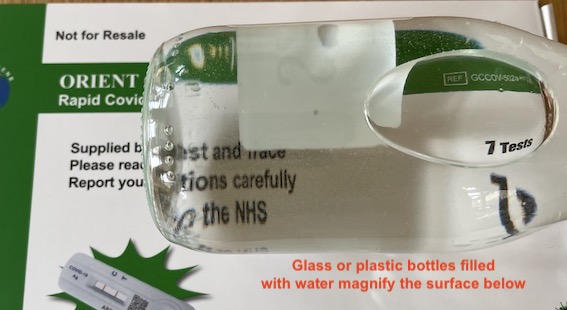
Use an interest in magnification as a springboard into other areas of learning
As children discover the pleasure of using magnifiers, they may want to find other ways of looking closely. A cardboard square works well. But likewise, from a magnification perspective:
- Seeing how a fly views the world with a multiple magnifier
- Some mirrors have magnifying capabilities. This is fascinating and it’s worth looking out for a second-hand one. I have a pocket make up one that is a 10x magnification so very powerful.
- Mobile phones and tablets have cameras that offer the option of taking close up or distant shots. You can also download apps that offer more magnification options.
- Looking through a glass crystal ball.
- Exploring the basics of a microscope. By holding one magnifying lens on top of another one, you can experiment to see items much closer up as you lift the top lens closer and further away from the one below. This is how a microscope works.
All of the above offer the option of further learning, play, exploration and discovery in different areas. Wow! All of this lends itself to stories, artwork, formal experiments in comparing objects at different scales and so on. The documentation at any age has the potential to be very creative.
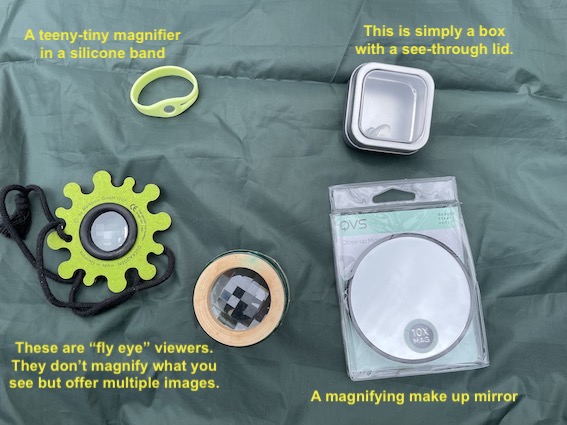
Finally, it’s always worth keeping an eye out for other interesting examples of magnification. Below is a rather creepy example of how someone (my husband) can look behind a large magnifying lens which we discovered at Dumfries House in East Ayrshire. What was brilliant about this example was the remains of charred wood on the grate attached – the sign referenced how magnifiers can be used as a tool for starting a fire and the placement of this magnifier supported children to do this safely.































Great collection ! And yes, muddy magnifying lens don’t work!
Thankyou for a helpful article. 🪶